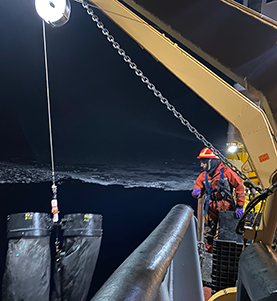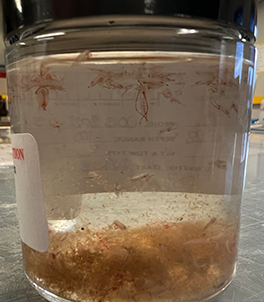Ashley Arroyo
October 8, 2022
Zooplankton are small animals that reside in the upper water column. Plankton are organisms that cannot effectively swim on their own, so zooplankton are carried along by ocean currents and mixing. Zooplankton range in size; most are too small to see without a microscope, and some are much larger and visible to the naked eye. For example, jellyfish are a type of large zooplankton! Unlike smaller planktic organisms (i.e., phytoplankton), zooplankton cannot produce their own food through photosynthesis, so they tend to consume smaller plankton. Organisms that consume zooplankton include certain species of fish, birds, and whales. Since these small organisms play a critical role in the food web, measurements and analyses of zooplankton are useful in understanding biological communities in the ocean.
At most of the stations, members of the science crew deploy bongo nets, which are a pair of large nets (that look like bongo drums, hence the name!) that collect zooplankton. To deploy bongo nets, weather conditions cannot be too cold or windy, or else the bongo nets will freeze or become too difficult to manage. When it is time to deploy the bongo nets (and when the weather permits), a few members of the science crew head out to the foredeck. The bongo nets are prepared by attaching one “cod-end” to each net. The cod-ends are essentially the filters of the bongo nets; they catch the zooplankton while allowing sea water to filter through. After the bongo nets are prepared, they are lifted over the side of the ship, and lowered to a depth of 100 meters. When the bongos have reached 100 meters depth, they are pulled back to the surface, collecting the zooplankton on the way up. Once the bongo nets are back on board, the members of the science crew ensure that all the collected zooplankton are in the cod-ends by hosing off the nets with sea water. The cod-ends are then disconnected from the nets and brought into the lab, where the zooplankton that were caught are filtered. The zooplankton samples are then moved into two jars: one jar is treated with ethanol, which will be used for DNA analysis of the zooplankton, and one jar is treated with formalin, which preserves the bodies so they can be easily identified by shape and size. The collected samples will be analyzed post-expedition.
In the Canada Basin, the data collected from bongo nets have provided important information about the biological communities that live in the Arctic Ocean. By analyzing the samples, we have learned what types of critters live in the water column, how large they are, their relative abundance, and how they are distributed spatially. Since the bongo nets have collected zooplankton since the beginning of the field program (20 years ago!), we have a long time series of zooplankton analysis, which is useful in examining how zooplankton are responding to physical and biogeochemical changes that have been observed in the Arctic Ocean due to climate change.


